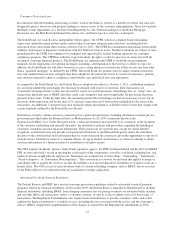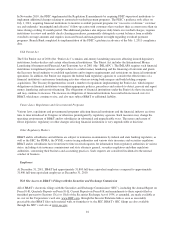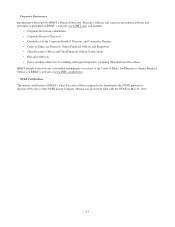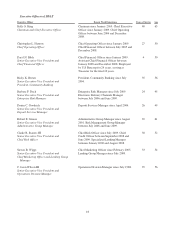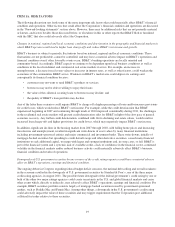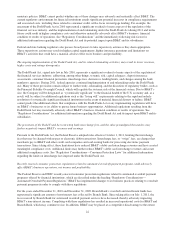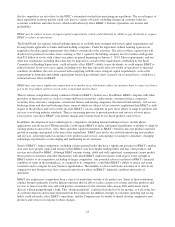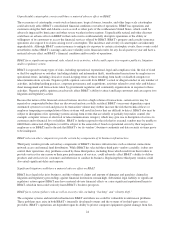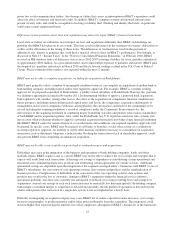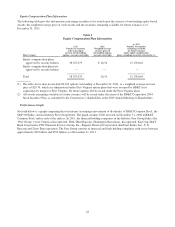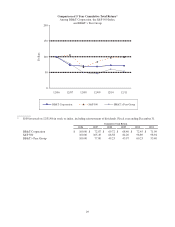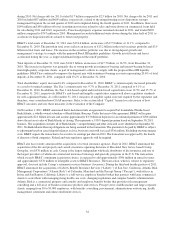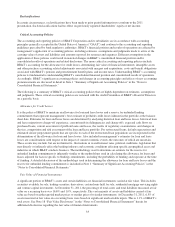BB&T 2011 Annual Report Download - page 23
Download and view the complete annual report
Please find page 23 of the 2011 BB&T annual report below. You can navigate through the pages in the report by either clicking on the pages listed below, or by using the keyword search tool below to find specific information within the annual report.that its competitors are not subject to the FDIC’s automated overdraft payment program regulations. The actual impact of
these regulations in future periods could vary due to a variety of factors, including changes in customer behavior,
economic conditions and other factors, which could adversely affect BB&T’s business operations, net income and
profitability.
BB&T may be subject to more stringent capital requirements, which could diminish its ability to pay dividends or require
BB&T to reduce its operations.
The Dodd-Frank Act requires federal banking agencies to establish more stringent risk-based capital requirements and
leverage limits applicable to banks and bank holding companies. Under the legislation, federal banking agencies are
required to develop capital requirements that address systemically risky activities. The effect of these capital rules will
disallow trust preferred securities from counting as Tier 1 capital at the holding company level for entities with greater
than $15 billion in assets, with a three-year phase-in period beginning on January 1, 2013. These requirements, and any
other new regulations, including those that may be imposed as a result of the requirements established by the Basel
Committee on Banking Supervision, could adversely affect BB&T’s ability to pay dividends, or could require BB&T to
reduce business levels or to raise capital, including ways that may adversely affect its results of operations or financial
condition. In addition, the costs associated with complying with the more stringent capital requirements, such as the
requirement to formulate and submit capital plans based on pre-defined stress scenarios on an annual basis, could have a
material adverse effect on BB&T.
BB&T may experience significant competition in its market area, which may reduce its customer base or cause it to lower
prices for its products and services in order to maintain market share.
There is intense competition among commercial banks in BB&T’s market area. In addition, BB&T competes with other
providers of financial services, such as savings and loan associations, credit unions, consumer finance companies,
securities firms, insurance companies, commercial finance and leasing companies, the mutual funds industry, full-service
brokerage firms and discount brokerage firms, some of which are subject to less extensive regulations than BB&T is with
respect to the products and services they provide. BB&T’s success depends, in part, on its ability to adapt its products and
services to evolving industry standards. There is increasing pressure to provide products and services at lower prices.
Lower prices can reduce BB&T’s net interest margin and revenues from its fee-based products and services.
In addition, the adoption of new technologies by competitors, including internet banking services, mobile phone
applications and advanced ATM functionality could require BB&T to make substantial expenditures to modify or adapt its
existing products and services. Also, these and other capital investments in BB&T’s business may not produce expected
growth in earnings anticipated at the time of the expenditure. BB&T may not be successful in introducing new products
and services, achieving market acceptance of its products and services, anticipating or reacting to consumers’ changing
technological preferences or developing and maintaining loyal customers.
Some of BB&T’s larger competitors, including certain national banks that have a significant presence in BB&T’s market
area, may have greater capital and resources than BB&T, may have higher lending limits and may offer products and
services not offered by BB&T. Although BB&T remains strong, stable and well capitalized, management cannot predict
the reaction of customers and other third parties with which BB&T conducts business with respect to the strength of
BB&T relative to its competitors, including its larger competitors. Any potential adverse reactions to BB&T’s financial
condition or status in the marketplace, as compared to its competitors, could limit BB&T’s ability to attract and retain
customers and to compete for new business opportunities. The inability to attract and retain customers or to effectively
compete for new business may have a material and adverse effect on BB&T’s financial condition and results of
operations.
BB&T also experiences competition from a variety of institutions outside of its market area. Some of these institutions
conduct business primarily over the Internet and may thus be able to realize certain cost savings and offer products and
services at more favorable rates and with greater convenience to the customer who can pay bills and transfer funds
directly without going through a bank. This “disintermediation” could result in the loss of fee income, as well as the loss
of customer deposits and income generated from those deposits. In addition, changes in consumer spending and saving
habits could adversely affect BB&T’s operations, and the Company may be unable to timely develop competitive new
products and services in response to these changes.
23




